Choosing the Best Brush for Stick Foundation
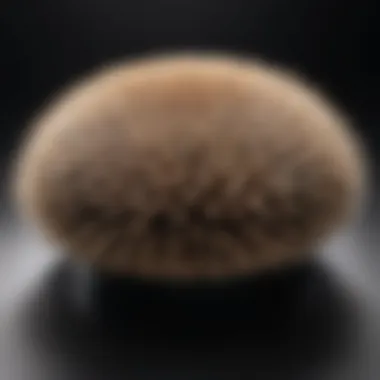
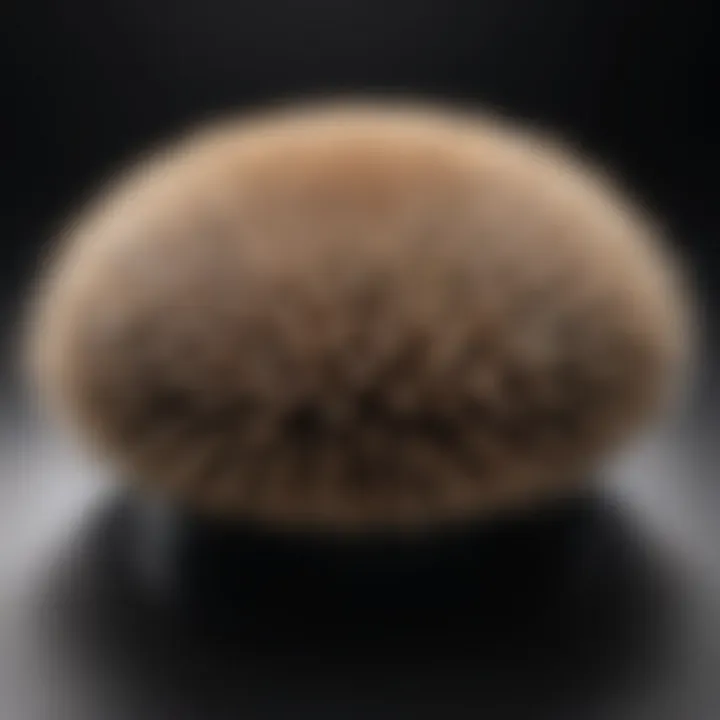
Intro
Applying stick foundation can be a nuanced process. The right brush can make a significant difference in achieving a smooth, even application. Many people overlook the importance of selecting the correct tools for their makeup routine. A brush's material, shape, and size can enhance the performance of the foundation, leading to a more professional finish. This section will detail key considerations for choosing the right brush and its application techniques.
Key Trends
Overview of Current Fashion Trends
In the beauty world, current trends emphasize a natural look. This means less heavy makeup and more focus on enhancing one's features. Stick foundations align well with this trend as they provide buildable coverage. Brushes that promote a seamless application are increasingly popular as they help create that effortless appearance. Brands are innovating their brush designs to cater to this preference, resulting in stiff bristles combined with soft tips, which help blend foundation evenly on the skin.
Popular Beauty Trends
Another trend within the beauty landscape is an increasing interest in eco-friendly products. Consumers are becoming more aware of the environmental impact of beauty tools. Brushes made from sustainable materials are rising in popularity. Material choices that are biodegradable or easily recyclable are becoming industry standards. Furthermore, there is a push among makeup artists and beauty enthusiasts to educate themselves on various application techniques, enhancing not just their skills but their overall beauty knowledge.
Beauty Tips and Tutorials
Skincare Routines for Different Skin Types
Before applying foundation, it is crucial to prepare the skin accordingly. Dry skin types may benefit from a hydrating primer, while oily skin can use a mattifying product. Understanding your skin type will not only help in foundation selection but also in choosing the right brush. All brushes have varying softness and density, affecting the end result.
Step-by-Step Makeup Tutorials
To apply stick foundation effectively, start with a clean face and a suitable primer.
- Use the Stick Foundation: Apply directly to the face in areas needing coverage, often in a dotting pattern.
- Select Your Brush: A densely packed brush will provide full coverage, while a fluffy brush will allow for a lighter finish.
- Blend Out: Use circular motions, moving outward from the center of the face.
- Layer if Needed: If additional coverage is necessary, repeat the process, taking care to blend well.
Sustainable Practices
Understanding Sustainable Fashion
Sustainable beauty aims to reduce waste and promote an eco-friendly approach in the cosmetics industry. This includes choosing tools that are long-lasting and made from eco-conscious materials. Many brands are beginning to offer brushes that fulfill these criteria, making it easier for consumers to make responsible choices.
Tips for Sustainable Beauty
- Invest in Quality: High-quality brushes last longer and reduce waste.
- Regular Cleaning: Take time to clean brushes frequently to maintain their lifespan and performance.
- Choose Refillable Products: Opt for makeup brands offering refillable options to minimize plastic usage.
"The right tools not only elevate your makeup game but also contribute to a more sustainable beauty routine."
By understanding the significance of both brush selection and sustainable practices, individuals can achieve a polished look while being mindful of their environmental impact. Each brush chosen should not just serve a cosmetic function but also align with one's values in beauty practices.
Prelims to Stick Foundation
Stick foundation has gained popularity in the beauty community for its convenience and versatility. It offers an easy way to achieve a polished look without the mess associated with liquid foundations. This section delves into the significance of stick foundations, discussing their unique features and the advantages they bring to makeup application. Understanding stick foundation is crucial as it sets the foundation for choosing the right tools for application.
Definition and Benefits
Stick foundation is a solid form of foundation that typically comes in a twist-up tube, resembling a stick. Unlike traditional liquid or cream foundations, stick foundations are more compact and travel-friendly. They provide a medium to full coverage, allowing for buildable application. One of the primary benefits is their ability to blend seamlessly into the skin, offering a natural finish.
- Convenience: The stick format means it can be applied directly to the skin without the need for a palette, making it ideal for on-the-go touch-ups.
- Versatile Application: It can be used for more than just the face; it can also be utilized for contouring and highlighting, providing a multi-purpose product in a single tube.
- Variety of Finishes: Many brands offer stick foundations with different finishes, from matte to dewy, allowing users to choose based on their skin type and desired look.
- Long-lasting Formula: Generally, stick foundations are long-wearing which is suitable for all-day wear, reducing the need for frequent touch-ups.
Utilizing a stick foundation can enhance overall makeup performance when paired with the optimal brush. This guide will explore the significance of selecting the right brush type, as this can make a drastic difference in application and achieved results.
Understanding the Role of Brushes in Makeup
Makeup application is an art and a science, where tools significantly influence the outcome. The brush is a pivotal instrument in this domain. Synthetic fibers or natural bristles can affect how foundation adheres to the skin. It determines finish and blending quality. Thus, understanding the role of brushes is crucial for anyone interested in utilizing stick foundation effectively.
Using the right brush can enhance not only the product's performance but also your overall makeup experience. Choosing an appropriate brush helps in achieving a flawless application. Furthermore, different brushes suit various makeup techniques. Therefore, knowing what to use and when becomes paramount.
When applying stick foundation, the texture and thickness of the brush will dictate how well the product blends into the skin. A brush can distribute the product evenly and build coverage without streaking. It influences not only how the foundation looks but also its longevity throughout the day.
In summary, the brush plays an indispensable role in achieving a polished makeup look. A deeper exploration of this topic reveals its impact on the application process, user satisfaction, and ultimately the results achieved.
Why a Brush Matters for Stick Foundation
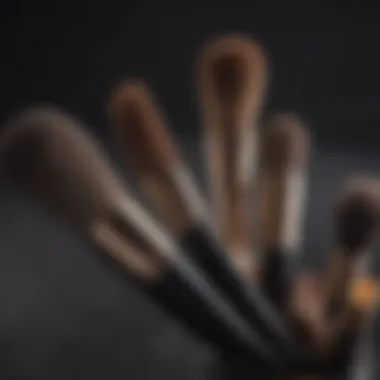
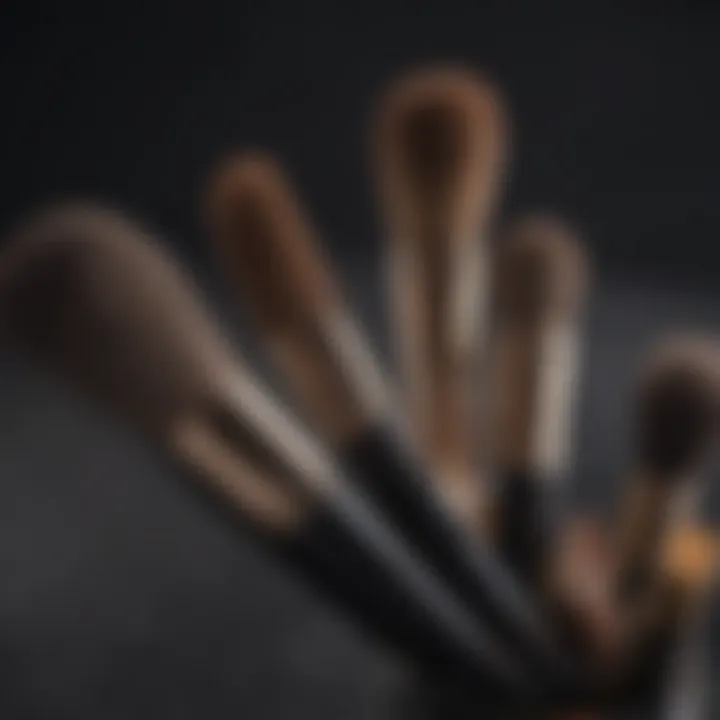
Brushes serve as an extension of one’s hand during makeup application. Specifically, for stick foundation, a brush matters significantly. Unlike using fingers or sponges, brushes offer precision and control.
Some key reasons why a brush is vital for stick foundation include:
- Even Distribution: Brushes help in evenly spreading the foundation on the skin, eliminating patchiness.
- Buildable Coverage: Using brushes allows users to layer product, accommodating different coverage needs.
- Precision Application: For hard-to-reach areas, brushes offer greater control compared to other tools.
- Smooth Finish: A well-chosen brush can provide a seamless finish, minimizing the appearance of imperfections.
When using a stick foundation, maintain a gentle touch with the brush. Many people notice that this method avoids disrupting the underlying skincare. A brush also prevents excess product from being wasted, enabling a more economical use of resources.
"Choosing the right brush transforms the application of stick foundation from merely functional to a work of art."
Ultimately, understanding why a brush matters for stick foundation elevates the approach to makeup, ensuring the process becomes both efficient and rewarding.
Types of Brushes Suitable for Stick Foundation
When selecting a brush for stick foundation, the type of brush plays a crucial role in achieving the desired finish. Different brushes have unique characteristics that can influence how the foundation is applied and how it looks on the skin. Each brush type offers distinct advantages, contributing to a seamless and well-blended complexion.
Flat Foundation Brush
A flat foundation brush is designed with a wide, flat bristle arrangement. This type of brush is effective for applying stick foundations evenly across the skin. The shape allows for quick coverage, making it an ideal choice for those who prefer a more straightforward application method.
- Application: The flat surface provides a smooth, streak-free finish, particularly on larger areas of the face, such as the cheeks and forehead.
- Control: This brush type offers more control, helping to reach specific areas with precision.
- Blendability: While it is excellent for applying product, some might find it requires additional blending to achieve a flawless look.
Buffing Brush
The buffing brush, characterized by its densely packed bristles, is specially crafted to blend foundation seamlessly into the skin. This brush is known for its versatility and effectiveness in creating a polished finish.
- Blending Power: The round shape and soft bristles work together to buff the stick foundation into the skin, minimizing any lines or uneven patches.
- Coverage Customization: Buffing brushes allow for buildable coverage. Users can apply a thin layer and subsequently add more product where necessary.
- Circular Motions: Using circular motions during application promotes a natural finish, making it particularly suitable for those looking to achieve an airbrushed appearance.
Duo-Fiber Brush
Duo-fiber brushes are unique in that they contain two types of bristles: synthetic and natural. This designed combination allows for a lightweight application, making it an excellent tool for stick foundation.
- Sheerness: The longer, softer bristles on this brush create a sheer application, perfect for those who prefer a more natural look or for those who wish to use less product.
- Layering Effect: It is effective for layering foundation; users can build coverage without the look of excess product sitting on the skin.
- Dual Functionality: Duo-fiber brushes work well with various formulas, making them a multifunctional addition to one's makeup tools.
Sponge Applicator
Though not a brush in the traditional sense, sponge applicators are often favored when applying stick foundation. They provide a different approach that can yield impressive results.
- Damp Application: Using a damp sponge can enhance the blending process, allowing the foundation to melt seamlessly into the skin for a dewy finish.
- Buildable Coverage: Similar to a buffing brush, sponges allow for buildable coverage and can be used to press the foundation into difficult areas like under the eyes.
- Versatility: Sponges can also be used for both liquid and cream foundations, making them a valuable tool for a variety of makeup styles.
Choosing the right brush or applicator for stick foundation matters immensely. The correct tools not only streamline your application process but also can enhance the overall look and feel of your makeup.
Choosing the Right Brush Material
Selecting the right brush material is crucial when it comes to applying stick foundation effectively. The choice between synthetic and natural fibers can significantly influence the outcome of your makeup application. The right material not only affects coverage and texture but also determines how the brush feels against your skin. Understanding these nuances helps in achieving a flawless finish while also considering your skin’s unique sensitivities and preferences.
Synthetic vs. Natural Bristles
Synthetic bristles are made from man-made materials, such as nylon or polyester. These brushes are popular for good reasons. They are often more affordable and can be easier to clean. Moreover, synthetic bristles typically do not absorb product as much as natural bristles, leading to less waste and more efficient use of your stick foundation. They are also a good choice for people with sensitive skin or those who prefer cruelty-free options.
On the other hand, natural bristles, made from animal hair, have unique properties that can enhance the application. They tend to be softer and can blend products more seamlessly into the skin. This can be ideal for someone looking for a softer finish or to create a more natural look. However, natural bristles may absorb more product. The maintenance also requires more effort. You should properly clean them regularly to ensure their longevity and performance.
Choosing between synthetic and natural bristles depends on your specific preferences, skin type, and desired finish.
Vegan Options
Vegan brushes have gained popularity for many reasons. They offer an ethical approach to beauty while standing out in performance. These brushes are typically made from high-quality synthetic materials, mirroring the effectiveness of traditional brush options without using animal hair. Many brands now focus on creating vegan-friendly brushes that provide the same benefits as natural bristle competitors.
Opting for vegan brushes can be a great choice if you are looking to align your makeup routine with a more sustainable lifestyle. They also come in various shapes and sizes, making it easier to find the perfect fit for your stick foundation application.
In summary, the material of your brush can have a significant effect on the application and finish of your stick foundation. It is important to weigh the pros and cons of synthetic vs. natural bristles. Vegan offerings also provide an ethical alternative without sacrificing function. Ultimately, your choice should reflect your makeup needs and personal values.
Brush Shape and Size Considerations


Choosing the right brush shape and size plays a significant role in the application of stick foundation. Different brush designs serve unique purposes, impacting not only the evenness of coverage but also the ability to blend seamlessly into the skin. When it comes to stick foundations, the ideal brush should facilitate smooth application while accommodating the contours of the face.
Influence of Shape on Application
Brush shape directly affects how product is applied onto the skin. For instance, a flat brush provides a different finish compared to a round one. Flat brushes are often favored for their ability to lay down product evenly across larger areas, such as the cheeks or forehead. They typically allow for precise, controlled strokes that can help minimize product streaking.
Conversely, a rounded brush is beneficial when working on the more intricate areas of the face like around the nose or under the eyes. The curved shape allows for easy maneuverability and blending, which is crucial for achieving a flawless look without harsh lines.
Additionally, brushes with an angled design can be particularly useful for sculpting and contouring. The slanted edge can sweep along the cheekbones and jawline, helping to define the face while applying stick foundation. Each shape offers unique advantages, and selecting the right one can elevate your makeup game significantly.
Choosing Size for Different Areas
Size is another critical aspect when considering brushes for stick foundation. Larger brushes are beneficial for the wider areas of the face, allowing for rapid application across the cheeks and forehead. On the other hand, smaller brushes excel at intricate detailing, making them ideal for the nose, under-eye area, and areas that require more precision.
When determining which size to use, consider the areas of the face you are working on:
- Larger areas (forehead, cheeks): Use bigger brushes, such as a flat foundation brush or a buffing brush. These can cover more surface area quickly.
- Smaller areas (nose, under-eye): Choose smaller, more precise options like a pointed brush or a duo-fiber brush. These allow for careful application and blending in tighter spots.
Ultimately, the combination of brush shape and size is essential for mastering the application of stick foundation. Proper consideration of both aspects leads to more effective use of the product, ensuring that it adheres well to the skin and blends effortlessly.
Application Techniques for Stick Foundation
Understanding the correct application techniques for stick foundation is essential for achieving a flawless finish. Stick foundation is known for its versatility and ease of use, but applying it effectively requires some skill. By mastering these techniques, users can enhance the performance of the foundation, ensuring even coverage and a natural look. Proper application can also minimize the risk of common issues like streaking or patchiness.
Basic Application Method
The basic application method is the cornerstone of using stick foundation effectively. This technique typically involves several important steps:
- Preparation: Start with a clean complexion and a suitable moisturizer. This helps in achieving a smooth base for the foundation.
- Direct Application: Glide the stick foundation directly onto the skin in areas where coverage is needed. Dots or stripes can be placed on the forehead, cheeks, nose, and chin.
- Blending: Use a suitable brush—like a buffing brush—to blend the foundation into the skin. Focus on blending outward from the center of the face for a seamless finish.
- Finish with Powder: If necessary, set the foundation with a setting powder, especially in areas prone to oiliness. This step can increase longevity.
This method is advantageous for those who prefer a quick and straightforward application. Proper technique in blending is essential. This ensures avoiding heavy spots that may create an uneven appearance.
Layering for Coverage
Layering is a crucial technique, especially when higher coverage is desired. Here are key points to consider:
- Thin Layers: It’s crucial to apply the foundation in thin layers. Begin with a light application, allowing for buildable coverage.
- Drying Time: Let the first layer set for a moment before adding more product. This prevents caking and results in a more natural finish.
- Targeted Areas: Focus on specific areas requiring additional coverage, like blemishes or redness. Applying more foundation only where needed prevents a heavy overall look.
- Blending Tools: A sponge can also be an effective tool for blending layers. The damp sponge helps in creating a more airbrushed appearance.
"Layering allows you to customize your coverage according to your daily makeup needs. It’s effective in balancing sheer and full coverage based on personal preference."
Using these techniques can greatly enhance the stick foundation experience. By focusing on basic methods and layering effectively, users can ensure their makeup looks polished and professional.
Maintaining Your Brush
Properly maintaining your brush is crucial for achieving flawless makeup application. A well-kept brush not only enhances performance but also prolongs its lifespan, ensuring that it remains effective over time. Dirty brushes can harbor bacteria, which can lead to skin issues such as breakouts or infections. Therefore, establishing a routine for cleaning and caring for your brushes is not just about hygiene, but also about maintaining the quality of your stick foundation application.
Cleaning Techniques
Cleaning techniques vary based on the type of brush material used, but a standard method applies to most cases. Here is a simple guide:
- Frequency: Clean your brushes at least once a week for the best results. If you use your brushes daily, consider a quick clean after each use.
- Products: Use a gentle shampoo or a dedicated brush cleanser. Avoid harsh soaps, as they may damage the bristles.
- Method:
- Drying: Lay the brushes flat on a clean towel to dry. Never stand them upright as water can seep into the ferrule, weakening the adhesive.
- Wet the bristles under lukewarm water, ensuring water does not reach the ferrule (the metal part).
- Apply a small amount of cleaner to the bristles and gently swirl or pinch the bristles to work the cleanser through.
- Rinse thoroughly until the water runs clear.
- Squeeze excess water and reshape the brush.
Proper Storage Practices
Storing brushes correctly is another key aspect of maintenance. Poor storage can warp the bristles or result in damage. Here are some effective storage practices:
- Brush Holder: Use a designated brush holder or container. This keeps them organized and protects the bristles.
- Avoid Heat: Keep brushes away from direct sunlight and heat sources, which can degrade materials over time.
- Clean Environment: Store brushes in a clean area, free from dust and moisture. Consider closing them in a drawer or a cabinet.
- Separation: If possible, store different types of brushes separately to avoid them rubbing against each other, which might crush the bristles.
Regular maintenance not only preserves the brush's integrity but also ensures that your application remains seamless and professional.
Popular Brands and Their Offerings
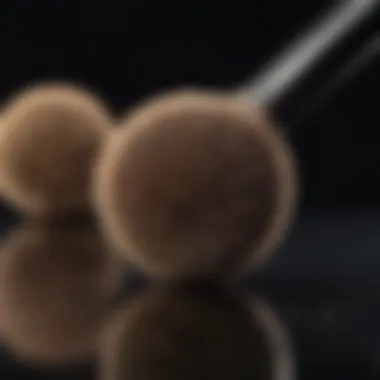
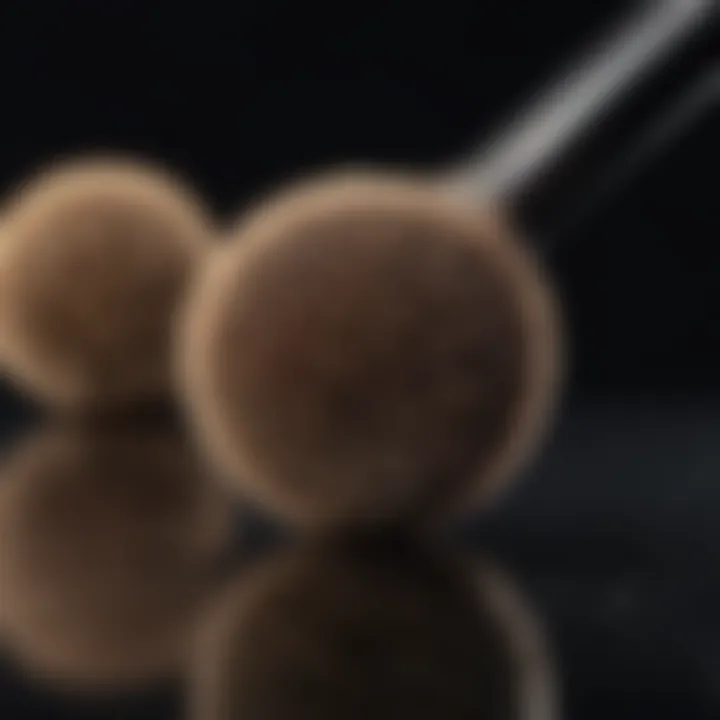
When it comes to choosing the optimal brush for stick foundation, the brand of the brush can significantly influence application results and overall user experience. Reputable brands often invest in research and development to create ergonomic designs, superior materials, and innovative features. Selecting a brush from a respected brand, therefore, ensures that users receive a product that can enhance their makeup application process and longevity. In this section, we will explore distinct offerings from high-end and affordable brands to provide options suitable for every budget and preference.
High-End Choices
High-end brands usually focus on quality, durability, and user satisfaction. These brushes tend to be pricier but often justify the cost with their performance and longevity.
- Tom Ford: Known for luxury, the Tom Ford foundation brush offers a plush feel and expert craftsmanship. The flat shape and soft bristles help in creating an even application without streaks, making it ideal for stick foundation.
- Giorgio Armani: Their brush for cream foundations is another favorite among makeup enthusiasts. The high density of the bristles aids in building coverage without excessive product use, which is essential for stick foundations.
- Guerlain: Guerlain’s offerings include innovative designs that often come with a built-in cap for protection. This not only extends the life of the brush but also maintains hygiene.
These high-end options are perfect for individuals willing to invest in long-lasting tools that deliver exceptional results.
Affordable Alternatives
Affordable brushes can provide excellent results as well, allowing a broader audience to access quality makeup tools without breaking the bank. Many lesser-known brands have introduced innovative solutions that rival their high-end counterparts.
- Real Techniques: Known for affordability and quality, Real Techniques offers a multi-tasking brush which blends stick foundation flawlessly. It’s easy to clean and maintain, making it a practical choice for daily use.
- e.l.f. Cosmetics: e.l.f. produces budget-friendly options that do not compromise on quality. Their brushes are ergonomically designed and work efficiently with stick foundations, widely popular among students and young professionals.
- Sonia Kashuk: Another affordable brand, Sonia Kashuk offers various brushes made from synthetic materials. They provide a soft touch and glide, producing a seamless finish on the skin.
Sustainability in Makeup Brushes
Sustainability has become a crucial topic in various industries, including the beauty sector. The production and disposal of makeup brushes can significantly impact the environment. Understanding this necessity motivates consumers to choose products that are not only effective but also environmentally conscious. This section details the importance of sustainability in makeup brushes, emphasizing specific elements and their benefits.
Eco-Friendly Materials
Choosing brushes made from eco-friendly materials is essential for reducing the ecological footprint. Many brands now offer brushes crafted from sustainable resources. For instance, bamboo handles are becoming increasingly popular because bamboo grows quickly and absorbs carbon dioxide efficiently. Other alternatives include brushes made from recycled plastics, which help mitigate waste in landfills.
Synthetic bristles are also a preferred choice when considering eco-friendliness. These bristles can be manufactured without animal cruelty, appealing to vegan consumers. Additionally, synthetic brushes often require less maintenance and can be washed easily, prolonging their longevity and reducing the need for frequent replacements. Investing in these materials contributes not only to personal beauty routines but also to a healthier planet.
Ethical Practices in Production
Apart from the materials used, ethical production practices are equally important in making sustainable choices. Companies that prioritize ethical sourcing ensure that all aspects of brush manufacturing comply with fair labor practices. This means fair wages, safe working conditions, and no exploitation of workers.
Supporting brands that engage in transparent supply chains fosters a more responsible beauty industry. It also encourages other companies to adopt similar practices in order to remain competitive. Understanding these ethical considerations helps consumers make informed decisions that align with their values. Maintaining awareness about how brushes are produced empowers us to choose wisely.
"Supporting sustainable and ethically made products not only enhances personal beauty routines but contributes to the larger goal of environmental preservation and social responsibility."
In summary, sustainability in makeup brushes involves a multifaceted approach. From selecting materials that are eco-friendly to supporting ethical production practices, consumers have the power to influence the beauty industry's environmental impact positively. This alignment with sustainable practices not only leads to better products but also creates a more responsible future for beauty.
Common Mistakes to Avoid
Using the right brush for stick foundation is not just about preference; it can significantly impact the overall makeup application. Avoiding common mistakes ensures that users can maximize the benefits of their tools. Here is an examination of frequent errors that may hamper the achievement of an ideal finish.
Using the Wrong Brush
Choosing the wrong brush for stick foundation application can lead to inadequate coverage and uneven texture. Many individuals may mistakenly select a brush that does not effectively blend the stick product into the skin. For instance, a dense brush might create streaks, while a looser brush might not pick up enough product.
It is vital to consider the density and shape of the brush. A flat foundation brush might work well for a smooth application, whereas a buffing brush can offer a more blended appearance.
Moreover, each brush has its unique purpose. Using a buffing brush for intricate areas, such as around the nose or under the eyes, may result in errors. Instead, a smaller, tapered brush would suit such tasks. Understanding these distinctions is essential to avoid the pitfalls of improper brush selection.
Neglecting Brush Maintenance
Brush maintenance is often overlooked in makeup routines, yet it plays a critical role in the longevity and performance of brushes. Failing to clean brushes regularly can lead to product buildup and bacteria growth. This may not only affect application but also the skin's health.
Cleaning techniques should be straightforward. Regularly washing brushes with gentle soap or specialized brush cleaner should be part of a makeup regimen. Moreover, storing brushes correctly is equally essential. Brushes should be kept in a dry, clean environment to avoid damage.
Neglecting these maintenance aspects will ultimately lead to ineffective application. A well-maintained brush will provide a smoother application and maintain hygiene, crucial elements for achieving a flawless makeup look.
"Proper brush maintenance is not an option; it is a necessity for those serious about their makeup routine."
Overall, addressing these common mistakes can lead to a more successful makeup application and a better experience using stick foundation. Being mindful of brush selection and maintenance is essential for achieving the desired results.
The End
Understanding the optimal brush for stick foundation is essential for achieving a flawless makeup application. This article has explored various facets of stick foundation brushes, including types, materials, and proper maintenance techniques.
Choosing the right brush can significantly enhance the application process, leading to better blending and overall appearance. Different brush shapes and sizes cater to various areas of the face, which allows for precision in application. For instance, flat foundation brushes provide a good base layer, while buffing brushes can create a seamless finish.
Proper brush maintenance extends the lifespan of your tools. Regular cleaning and appropriate storage prevent the buildup of bacteria, which is crucial for skin health.
Moreover, the growing awareness of sustainability in beauty products stresses the importance of ethical practices in cosmetic manufacturing. Selecting brushes made from eco-friendly materials supports a responsible beauty routine.
In summary, factors such as brush type, material, and maintenance are key elements in optimizing stick foundation application. Being mindful about your brush choices can elevate your overall makeup experience.



